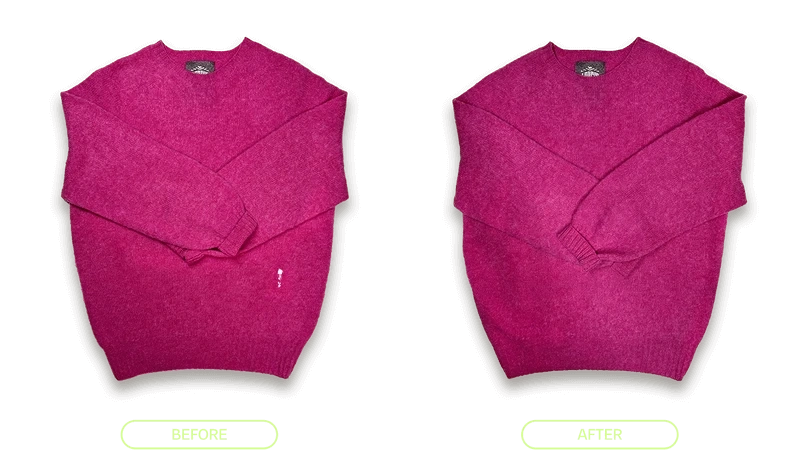If you’ve found moth holes in your clothes it’s important to act quickly. These pests tend to attack fabrics that contain natural fibres, such as wool and silk.
Start by emptying your wardrobe and giving everything a thorough inspection. Look especially carefully at areas that are prone to damage such as the underarms, cuffs, neckline and crotch of pants.
Clothes Moths
Clothes moths feed on the natural fibers of wool, cashmere, angora and animal hair; furs and rugs; and silk. They prefer dark, warm environments where they can hide and lay eggs. Damage usually appears in hidden locations, like underneath collars or cuffs and in crevices of upholstered furniture. Larvae are masters of camouflage and can resemble clothing lint or dirt.
The most effective way to control moths is prevention. This means regularly vacuum dimly-lit closets and drawers and sifting through all your clothing to check for signs of damage, including tiny holes. Regular washing of machine washable clothes at the highest temperature recommended on their labels will also help, as will putting non-machine-washables in the dryer for several hours. Pheromone traps can also be used to attract and catch flies that parasitize the larvae. Another option is freezing, either by placing items in the oven for 30 minutes at a high temperature or by enclosing them in plastic and leaving them in the freezer.
Carpet Beetles
Unlike moths, which chew holes throughout a garment, carpet beetle larvae feed on only one small area of the fabric, leaving irregular holes. They also leave behind cast skins as they molt, which can trigger allergic reactions in some individuals. Adult carpet beetles are attracted to flowering plants such as crape myrtle, spiraea, queen Anne's lace, daisies and wild asters; they may also infest houses.
Larvae are most often found in dark, undisturbed areas such as closets, chests and boxes. They attack woolens and other animal-based materials such as fur, felt, leather, feathers and stuffed animals. They also feed on dried fruit, nutshells and some plant products including seeds and grains.
Proper storage can prevent fabric beetle infestations. Clothes and blankets in regular use are seldom attacked, but items stored for extended periods can be infested by larvae feeding within fabric folds. Storing susceptible items in airtight containers or using moth balls containing naphthalene or paradichlorobenzene (PDB) can help deter these insects.
Cockroaches
While they may not chew through clothes like their cousins do, cockroaches can cause moth holes in clothing and other fabrics. These insects can be drawn to natural fibers by things like food stains, human perspiration and animal feces, and will also feed on silk, cashmere, wool, fur, feathers, leather and other similar materials.
A close examination of a moth hole often reveals the cylindrical pupal case and loose “frass” of moth larvae, indicating that the webbing clothes moth Tinea pellionella (pictured above) caused the damage. Webbing clothes moth damage is typically darker in color, and the fabric around the hole will often appear wrinkled or depressed as a result of the insect's feeding tubes.
Keeping an eye out for signs of moth infestation, such as a musty smell or small holes in clothing, is the best way to prevent moths and other pests from ruining your wardrobe. Regular cleaning, storing items properly, and using pheromone traps for monitoring can all help to keep your closets and drawers moth-free.
Silverfish
When mysterious holes or tatters appear in your clothes, it’s often because of fabric pests like moths, silverfish, crickets or cockroaches. These wingless insects can cause damage to linen, silk, wool, cotton, and even faux fur.
These pests breed and lay their eggs in dark, undisturbed places. They feed on a variety of vulnerable items including paper, glue in books, and woven fabrics like clothing.
To avoid moth hole infestations, keep garments clean and dry by washing them regularly with fabric-specific detergent. When packing away clothing and linens, use cotton or canvas fabric pouches that allow for breathability. Avoid storing these fabrics in cardboard boxes or plastic storage containers as they can promote humidity. Spritzing your closet and wardrobe with cedar blocks and lavender pouches can help deter silverfish and other fabric pests. These odors emit a noxious smell that’s repulsive to them. You can also use a neem-based insecticide if necessary. Identifying what type of moth or silverfish is making holes in your clothes and taking the proper steps to eradicate them can save you time and money on costly repairs!



